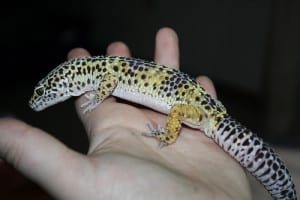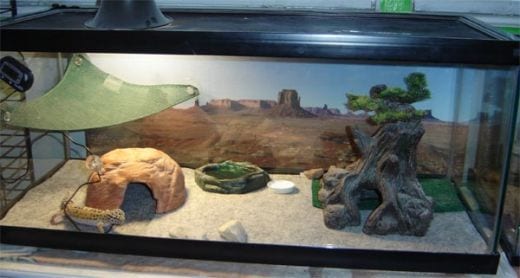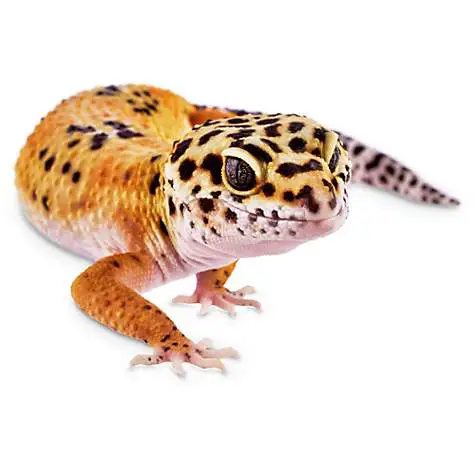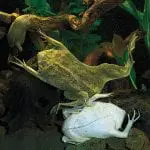Geckos are lizards that come from the family of reptiles. Reptiles are cold-blooded types of animals. They lay eggs too. In the world, there are over 1000 species and kinds of geckos.
The two main gecko groups have eyelids and blink like humans, whereas the others are those without eyelids and cannot blink. In terms of size, they are very small and even shorter than a ruler. Their bodies have pads on their toes. These pads are with tiny hairs which they used for grabbing and climbing on to smooth surfaces. They climb so well as they are on the building’s surfaces. To balance, they use their long tails. Their lifespan is from 10 to 20 years. Geckos are popular pets. Their needs vary from each species.
For beginners, the gecko is ideal. They are handled easily and comes in various colors. They come in colors like white, yellow, and spots of dark dots. The young start having stripes then becoming spotted gradually. They also come in several colors and different variations of patterns. It is called as morphs that usually involves the rainbow colors. Pet owns like certain colors while those wild types are affordable and available.
Have you heard of the term ultimate gecko? These are geckos that fascinate their keeper for their beauty, giving pleasure and live long. Potential owners are lucky to have these geckos easily from breeders and pet stores.
Common Species of Gecko Pets
1. Leopard Gecko
This gecko is known for being one of the easiest to keep. These geckos come from the West of India to Afghanistan as well as Iraq. They are recommended first for their sturdiness and the ease of caring vital for their health. They are nocturnal and terrestrial. They measure 10 inches and weigh 150 grams. The males are larger than the females, and their bones are heavier. In captivity, they live for 15 to 30 years or more.
Children who are 8 years old and above can surely handle these pets for these geckos are small, gentle, and easy to handle. Take note that their tails come off after being exposed to stress in the aquarium or handling. Regeneration of the tail is in turnip shape, which is different from the original.
For the setup, a glass terrarium with a durable screen top or plastic tubs that are well-ventilated can be used. It has 10 large gallons and put at feet tall. The plastic tubs will at 16-quart in capacity, having a lid that is well-fitted. With this setup, an adult male and female can live or three adult females with similar size. Don’t put two male geckos together as they may kill each other. Young geckos of similar size can be put in this setup.
A moist hide must be provided to having vermiculite or moss to help the gecko in shedding. For the furniture, there should be rocks or woods that should be anchored for it not to tip or crush. Include plastic plants too. Use simple substrates like newspapers, carpet, or paper towels. Don’t put ingestible substrates like pea and sand. Leopard can ingest it due to their curiosity.
In addition, basking sites having a temperature of 86 to 88 F is ideal. Use incandescent lamps having low wattage. For the lighting, using ultraviolet lighting is optional, but if you have live plants, they get the advantage of this light. Turn the lights off at night.
These geckos are purely insectivorous. They should be given commercial foods like insects, crickets, super worms, and mealworms. Feed the adult every 3 week-old or ¾ inch of cricket. The wax worms should not be given daily due to their high content of fat. Give gut-loaded insects and calcium supplements as well as vitamin D3, A, and phosphorous. For their drinking, provide a water dish.
2. African Fat-Tailed Gecko
This is the cousin of Leopard gecko. They come from Africa. They share various sizes, shapes, nocturnal and terrestrial behaviors, and weight. They live for more than 15 years. Their natural wild form is banded and striped. Their morphs increased to a large number like their other cousins like ghosts, oreo, zero, white-out, Zulu, and more.
They are kept in captivity easily. They are mild-mannered and tolerate handling. For their terrarium, they can have a similar one with the leopard gecko. For fat tails, their moist hide box is given more importance, for they come from a moister environment. Do a daily misting of 70 to 80%. Use orchid bark or peat moss to increase the humidity levels. Regimens are very similar to the leopard gecko, but they prefer crickets. They can be fed with cockroaches too.
3. Crested Gecko
These geckos are known for ease of care, beauty, and longevity. They are charming and soft-skinned, having big eyelashes. They are gently making them be handled easily. For the first gecko, they are a good choice.
They are arboreal and nocturnal, having a large head and wide body. They measure 4 to 5 inches, not including the tail, and weigh 35 grams. They get sexually mature at their 15 to 20 months. unlike other geckos, they cannot regenerate after a tail coming off. The missing tails are termed as frog butts. Although they lose their tails, they can still live normal lives.
Their terrarium should be vertically oriented. Adults one should be kept in 20 gallons. A male can be kept with many females but not with 2 females. You can purchase a tropical kit that includes accessories and devices for humidity and temperature measurements as well as water and food dishes, substrate, walls, and artificial plants. if not, you can make your own, just buy a kit and design your own.
Don’t forget hiding places. They love cork bark and bamboo. Put a long bamboo piece diagonally and cork bark or a PVC pipe. The substrate could be orchid bark or peat moss. Orchid bark should be larger than the mouth of the gecko. This is to prevent ingestion.
A simple terrarium would be a 20-gallon plastic having a screen top. This setup may not need substrate, for they are arboreal. At day time, the temperature can be from 70 to 80. Do the same technique with the leopard gecko for the heat temperature.
Ultraviolet light is not necessary. Give a Repashy’s Crested Diet. This has fruit-flavored protein having minerals and vitamins. Mix 2 parts of water to 1 part of food in a dish. Replace it with fresh water after a day. Insects like roaches and crickets bought commercially can be given. When they get older, their preferences change; they prefer fruits and not insects. Always include vitamins and supplements. Water must always be readily available. There should be 50% of humidity. Mist manually or use a humidifier.
4. Gargoyle Gecko
This is a beefy-bodied type of lizard. They weigh 35 grams and grows for 4 to 4.5 inches in length. They are arboreal, nocturnal, and tropical. They live for over 15 years. They live in scrub brush and forest. They walk on the roads at night. They are captivating for their looks, known to be unique. They have a bony protuberance around the head above their ears. Their eyes are marbled and fascinating. Striped and reticulated morphs are the most common. The stunning one is the red-striped morph.
These geckos are not sociable with their fellow or even people. Thus, cautious handling should be done. They could bite and don’t hang out with others. For climbing, use grapevines. Their cut tails can regenerate. They are insectivores but eat insects too.
5. Mossy Prehensile-Tailed Gecko
These geckos have become so popular for their beautiful and mossy-like patchworks of red, green, brown, and white on their shoulders. The less distinctive patterns. Their eyes are gold and captivating.
They possess many characteristics. They are 5.7 inches long from their snout to vent and weigh 40 to 60 grams. They live for 20 to 30 years. Their tail regenerates partially, so they tend not to drop their tails off. They are arboreal, tropical, and nocturnal. The husbandry and set up are similar to the crested gecko, but more climbing furniture and vertical space must be given more attention.
6. Giant New Caledonian Gecko
These are the favorites because of their beautiful color and large size. There are 2 types; the smaller R. l. henkeli and the larger R. l. leachianus. They are among the largest, making them a good choice. They measure 13 inches from their snout to vent. The Grande Terre weighs 450 grams. They have short tails, thick bodies, and large heads.
Morphs are green, pink, yellow, orange, red, and more. they live for 20 to 35 years. The terrarium must be big. It should be a 40 gallon for a single adult, while a pair would be in a 50 gallon. These geckos live in both tree hollows and trees. There should be bamboos or branches for climbing. Their favorite is cork bark. Plants should be sturdy so as not to be crushed by geckos.
House them in single or in pairs. Juveniles don’t need a large setup. For food, give them fruits or insects. The young prefer insects. The Grande Terre like insects such as super worms and crickets.
7. Tokay Gecko
These are found in Indonesia, India, and Asia. They are among the largest. The males are 14 inches in length and weigh more than 300 grams. They are visually appealing with their bright and red spots. Like the others, they are nocturnal, arboreal, and terrestrial.
Lost tails are regenerated. It is very social to offspring and mates. They live well in their terrarium. They are kept in male to female pairs or with many females. They can bite most, especially if they are not handled in their juveniles. They are insectivores.
8. Madagascar Ground Gecko
As their name implies, they are found in some parts of Madagascar. They chase insects at night time and stays under the leaves at day time. They aren’t large like the others having 5 ½ inches in length. They are active and alert to find for their prey.
Their eyes are large, having gold to copper colors. Their morphs are just striped and banded. Handle them minimally, for they are a bit jumpy. The tail doesn’t regenerate. They don’t live that long. Set and husbandry are like that of the African gecko, but they need 60 to 70% of humidity. A moist box would be beneficial. The substrate would be orchid bark, paper towel, and peat moss.
9. Giant Day Gecko
These are also from Madagascar. they are big for they can reach 7 to 12 inches. They are diurnal, having bright green color in the body and red marks on the face and their heads. Red markings are not true to all. They don’t like being handled for their delicate skin.
Tails don’t regenerate after being cut. Keep them in male to female pairs or single. Their terrarium should be a glass and screen combination. For lighting, it should be bright basking with a fluorescent bulb. For heat, use incandescent. Drop the temperature to the 70s at night. Put a 2 inches’ bamboo or a pipe across the terrarium. They are insectivores. Mist their terrarium for at least once a day. Don’t forget the freshwater.
10. Neon Day Gecko
They are diurnal and tropical. They have blue and black stripes and a yellow-green head. This gecko is striking and needs limited handling. They live just for 10 to 12 years. They need a small terrarium of 10 gallons. Basking would be from 85 to 95 degrees. Keep them in male to female pairs or a male with multiple females. They eat insects or fruits.
Choosing the Right One for a Pet
After knowing the commonly kept geckos, next is to decide which one you prefer. Is it difficult to choose? Reptiles require daily maintenance. They can be left alone as you are out. For their food, they need to eat live insects. If you are sure about which one you like, consider the difficulty of keeping them in captivity, are they docile and can they be handled, do they need live insects, and think about the price, equipment, and maintenance.
It is recommended that you get a captive-bred from a trusted breeder. Wild geckos could be carriers of ailments or diseases. Go for geckos that have a healthy appetite, complete toes, tails and fingers, no dry patches, and have clear eyes.
Difficulty
In choosing, ask yourself if you can provide the needs and care gecko’s need like the terrarium, good light, right humidity and temperature, and more although some species easily cared than the others. Not being able to give these needs can cause them death. For a beginner, leopard geckos are fit. Crested geckos are the second pick. The fat-tailed ones are also a good choice too. The Tokay are flying gecko are aggressive but beautiful. Others should be kept by the experienced ones.
Handling

Geckos are not the type that you can play or cuddle. They do well with just being watched. Leopard and crested ones have the tolerance for handling, especially to children. They sit patiently except when they are startled. The day geckos don’t want being handled regularly. Their scales are fragile and wounded easily, plus they get scared easily, great jumpers, and very fast. Some species can regenerate their tails while others cannot.
Don’t pick or grab them by their tails for the reason that their tails are often dropped as a defense against their predators. Some regenerate their tails, but others cannot. They should be fed well and isolate them from their mates until their tails have regrown.
Will the Gecko Need Live Insects?
Most of them like fresh food. Not moving food is not eaten. Very few like flower nectar. In the wild, some eat nectar, but they eat insects too to survive. Respashy foods made powder for crested gecko having minerals, vitamins, and nutrients that gecko need.
Price and Availability
The geckos caught from the wild are cheaper because of the parasites they might have or due to stress. In fact, they are banned from lots of countries. Leo or crestie can be found easily, while others need a longer search. Breeds can be bought from hobbyists or breeders instead of pet shops. You can go to reptile shows too.
Also, think about your expenses with bulbs, lights, and terrariums. Think about your electricity bills. Colder places require more lights and bulbs. The larger geckos need bigger terrariums and more maintenance.
Behavior
Most species of gecko share similar behaviors and temperaments. Most of the pleasant and docile; however, some still don’t want to be handled frequently as it is stressful for them. The leopard gecko, tokay, crested, and African fat-tailed geckos are all nocturnal. They are active at night, but some species are diurnal.
They are not vocal, but some make noises like barking, clicking, and chirping, especially in defending their area or courting a mate. Usually, they are silent. They are not aggressive, usually except when two males are put in one enclosure together. Thus, separating them is the key to prevent attack and fight or even death. It is not known for them to attack humans.
Housing

The care requirements are different for each species, but most have to keep in an enclosure with branches, water dishes, secure lids, and a hiding place. Tight lids are recommended for geckos not to escape. Most of them need a 10-20-gallon aquarium. Some need small enclosures, while others require large ones.
For substrate, orchid bark and coconut husk are good. They keep moisture and not harmful to geckos. Newspapers and paper towels can be used too.
Heating and Humidity for Geckos
Ideally, the range of temperature would be 70-90 degrees, but others need up to 100 degrees. Heating and light pads are used to achieve these. Proper temperature for the species should be provided. Two sides must have different temperatures. The other side is cold whereas the other one is warm.
For nocturnal, there is no need for UVB bulbs except for the diurnal ones. The UVB rays are necessary for their growth, activity, and appetite. There are bulbs for light and heat. There should be a cycle to light the enclosure. The white light should be visible at day for your gecko not to be confused and stressed. The humidity should be from 70-80%. Mist the enclosure with water and put a big bowl. To measure, use a hygrometer.
Feeding
Most of them don’t eat vegetables or plants. They eat insects instead of wax worms, mealworms, cricket, and super worms. Mealworms and crickets are stapled while the wax worm and super worms are given as a treat. Some eat fruits and formulated diets. Regimens vary according to species and age. Insects must be gut loaded. Dust it with calcium as a supplement to their diet.
Substrate
The young ones should be in sand or even calcium sand. They can ingest it and have intestinal blockage. Instead, use paper as they are easy to change and absorbent if not outdoor or indoor carpets work too. Don’t use wood shavings, for they can cause wound in the gecko’s feet. The oils can be irritating too. Put the food dish in a separate dish to avoid the ingestion of their substrate.
Caring for a Baby Gecko
Again, get your gecko from trusted breeders, for they are healthier. A baby gecko will make a stronger bond with their owner. They are charming and cute, but they are smaller. They need more care, of course. Feed them with live insects. Give smaller insects like crickets or mealworms. Don’t give large ones. Put a small dish or do feeding by your hand. Take the uneaten food from the enclosure. Give your baby gecko with fresh water daily. Keep the dish clean every day.
Avoid touching or handling them, for they are skittish. Let them adapt to their new environment. Handling them is stressful and harmful to them. After some time, you can hold them for 5-15 minutes daily. Don’t put pressure when handling. Wash your hands well before handling them as their skin tends to absorb chemicals. To protect your health, wash your hands after too.
To hold, let them sit on your palm and offer you other palms, for it to climb on it. Do this process repeatedly.
Common Health Problems
Geckos are prone to some health problems, including the following:
- Stomatitis. This is called the mouth rot. It has to be treated right away. There is a red discoloration around the mouth and some pus too.
- Respiratory issues. It is indicated by drooling and wheezing. It is caused by low and draft temperature in the enclosure.
- Parasites. They can occur externally and internally. Small mites, worms, and eggs could be on the skin’s surface or feces. Infections would be in a red rash, making shedding difficult. Internal parasites cause unusual droppings, sluggishness, and changes in appetite.
- Dysecdysis. This is a shedding problem for geckos that don’t have the proper humidity in their own enclosures.
Interesting Facts
1. Geckos have amazing toes.
Geckos have specialized toe pads that let them stick to any surface except Teflon. It is their talent to scurry along the slick surfaces like ceilings or windows. It is not because of glue but their nanoscale hairs in their toes. Their toes are soft for flow, intimate, and continuous surface contact. Their toes are covered with hairlike and stiff setae.
2. Their eyes are 350 times more sensitive to light.
Their eyes are adapted for hunting at night. They can differentiate color in the dim moonlight. The sensitivity is much higher than that of human eyes. This is because of their large cones and optics. Thus, at low light, they use color vision. Their eyes are sensitive to green and blue.
3. They produce sounds to communicate.
They bark, clicks, and chirps. They do vocalize to communicate with their fellow geckos. The barking or chirping signifies a display or territory or courting.
4. Some of them have no legs that make them look like snakes.
Some species lack forelimbs but have hind limbs that look like flaps. They are called then as snake lizards.
5. They can detach their tails but regenerates after.
This is a response to a predator, most especially when they are threatened. This is a way to escape too. In addition, it is due to stress or infection.
6. They use their tails to keep fats and nutrients.
Their tails are storage for fats and nutrients, especially when there is scarcity in food. Unfortunately, not all geckos can do this.
7. They live for a long time.
Depending on the species, most geckos live for 10 to 20 years or more. They have a long lifespan like other reptiles, with incredible survival skills they really needed in the wild.
8. Some species don’t have the eyelids.
As a result, they lick their eyes in order to clean them.
9. They are masters of colors.
They stand out with their bright colors. Others blend into their environment like chameleons. Geckos are appealing in their own ways, making exotic pet lovers adore them.
10. They mimic dead leaves perfectly.
They look perfectly like a leaf in the forest. This is a method to escape from predators.
11. Some of them can fly.
Some are arboreal and can fly from one tree to another using the flaps on their feet.
12. The smallest one measure 2 centimeters.
This is the dwarf gecko and the S. parthenopion that measures 0.63 inches only.
Pros and Cons of Raising a Gecko
Pros
- These lizards are easy to find, and caring for them is easy too.
- They are quiet pets and content generally.
- They are docile and easy to handle.
- They are not aggressive.
Cons
- They have extensive needs for decoration, feeding, housing, and lighting.
- They are not responsive like other pets.
- They are fed on insects, fruits and need supplements too.
- Some have a foul odor.
- They can be loud.
- Housing can be expensive.
- Labor is intensive.
- There are precautions to consider.



